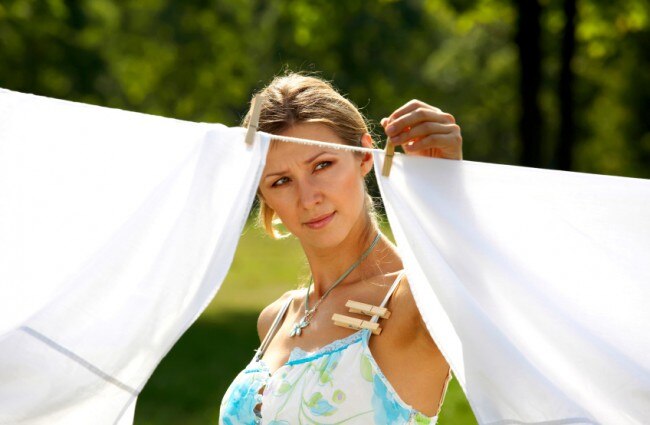We are a nation of unabashed laundry lovers. We worship at the altar of clean smelling laundry, and revel in all of laundry’s accouterments: stain removers, bleach, fabric softeners, and dryer sheets. But few of us realize the toll obsessive laundering takes on the planet.
A 2010 peer-reviewed study by Duke University’s Center for Sustainability & Commerce Director Jay Golden examined energy, carbon and water impacts from residential laundry in the United States. The report found washing and drying clothes in the average American household was responsible for consuming the following in a year period:
9,718 gallons of water
1,991 kWh of electricity
1 metric ton of CO2-e emissions
The biggest electricity hog is the clothes dryer, which uses 71% of the electricity use in a laundry cycle. The report points out that “If Americans adopted European and Asian standards, calling for the use of front load washer and dryers, washing in cold water only and hanging clothes to dry half the time, the environmental and economic benefits would be drastic.” Amazingly, these small changes, if done collectively, would be equivalent to removing 12.1% of passenger cars of roads in the United States or taking 23 coal plants off the grid. And more than 60% of water consumption (512 billion gallons) used while laundering could be reduced through these strategies.
With a few little tweaks in how we approach our laundry, we can make a huge difference. Here are ten of the best ways to lighten your environmental load.
Go cold
About 90 percent of the energy associated with washing your clothes goes to just heating up the water, an unnecessary waste of energy. Be sure you are using a detergent formulated to work well with cold water, and turn that knob to cold.
Toe the line
A clothes dryer is certainly convenient, but in the warmer months it’s hardly a necessity. Hang it old school on a line to dry, and you will be getting back to roots plus saving a ton of energy. A household running a dryer 200 times a year could save nearly half a ton of carbon dioxide by switching to a clothes rack or washing line. While some homeowners’ associations and municipalities oppose hanging clothes out to dry, the pro-line drying movement, headed up by Right to Dry, has made huge strides to overcome clothesline resistance. So far, lawmakers in 19 states have agreed that the traditional method of drying laundry is not only cheaper but better for the environment. These states have enacted “right to dry” laws that prohibit clothesline bans.
Wear twice or thrice
If you think wearing an item once merits tossing it into the hamper, think again. The simplest way to cut back on laundry is to do less. Wear your clothes twice and maybe even thrice before relegating them to the wash.
Do full loads
Maximize your wash cycle by committing to a full load. While half loads use a little less energy each time, they work out as much less efficient per item washed.
Discriminate amongst detergents
Toxins in conventional detergents harm the environment, having an especially negative effect on ecosystems. Look for labels that indicate a product is biodegradable, phosphate-free, and made from plant- and vegetable-based ingredients instead of sourced from petroleum.
Forego the niceties (ironing, fabric softeners, dryer sheets)
The chemicals–such as synthetic fragrances—found in conventional dryer sheets and fabric softeners are similar to what is found in conventional detergents. Fragrances contain hormone disruptors that infiltrate our water supplies and even oceans, causing havoc amongst marine life. And now you have a perfect excuse to not iron—just say it consumes too much electricity.
Choose the right machine
An Energy Star-qualified front-loading machine can save as much as 7,000 gallons of water per year, compared to a top-loader. According to treehugger.com, over the approximately 11-year life of a washer, that’s enough water to fill up three backyard swimming pools or provide a lifetime of drinking water for six people. Plus, an energy efficient washer will save you roughly $550 in operating costs over its life cycle, making it a worthwhile investment.
Nix the chlorine
Chlorine is known for being detrimental to the environment, as well as a human irritant. Switch to a non-chlorine bleach, such as hydrogen peroxide, which will adequately fulfill your whitening/brightening needs. According to Real Simple magazine, if every U.S. household replaced just one 64–ounce bottle of chlorine bleach with non-chlorine bleach, we could prevent 11.6 million pounds of chlorine from entering our environment.
Sort it out
Somehow I never got the memo before, but apparently in order to get the most from your dryer, you need to thoroughly sort your laundry. Dry towels alone, and separate heavyweight and lightweight items. (That’s why my loads mixed with towels always took so many cycles to dry!) Loads of similar-weight laundry will dry faster and more evenly.
Lint litany
Clean the lint filter in the dryer after every load to improve air circulation and shorten drying time. It’s an extremely satisfying task, verging on the compulsive, that just got upgraded from anal to sustainable.

